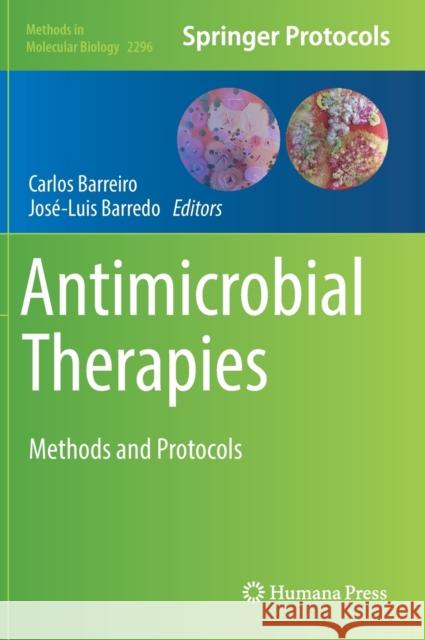Antimicrobial Therapies: Methods and Protocols » książka



Antimicrobial Therapies: Methods and Protocols
ISBN-13: 9781071613573 / Angielski / Twarda / 2021 / 443 str.
Antimicrobial Therapies: Methods and Protocols
ISBN-13: 9781071613573 / Angielski / Twarda / 2021 / 443 str.
(netto: 688,46 VAT: 5%)
Najniższa cena z 30 dni: 693,97
ok. 22 dni roboczych
Dostawa w 2026 r.
Darmowa dostawa!
Part I: General Overview
1. Worldwide Clinical Demand for Antibiotics: Is It a Real Countdown?
Carlos Barreiro and José-Luis Barredo
Part II: Antibiotic Screening
2. Collection, Extraction, and In Vitro Antibacterial Evaluation of Plants Used in Traditional Medicine
François Chassagne and Cassandra Leah Quave
3. Microbial Isolation and Characterization of New Antibiotic‑Producer Strains from Decayed Wood
Óscar Velasco-Rodríguez, Mariana Fil, Laura García-Calvo, Katarina Kosalková, and Carlos Barreiro
4. Characterization of Extremophilic Actinomycetes Strains as Sources of Antimicrobial Agents
Diyora Abdukhakimova, Zhannur Markhametova, Saikal Shamkeeva, Ainur Zhulamanova, Lyudmila Trenozhnikova, Vladimir Berezin, and Azliyati Azizan
5. Dilution-To-Extinction Platform for the Isolation of Marine Bacteria Producing Antitumor Compounds
Xulio Benítez, Jesús García, Elena G. González, and Fernando de la Calle
Part III: Methodologies
6. Screening Systems for Stable Markerless Genomic Deletions/Integrations in Streptomyces Species
Jan Kormanec, Bronislava Rezuchova, and Renata Novakova
7. Antibacterial Assay in a Screening Project
Francisco Romero and Antonio Fernández
8. Screening of Antibiotic Gene Clusters in Microorganisms Isolated from Wood
Mariana Fil, Óscar Velasco-Rodríguez, Laura García-Calvo, Alberto Sola-Landa, and Carlos Barreiro
9. Methods in Screening Antiviral Drugs Against Enterovirus 71
Nadia Abubakar Omar Abubakar Bajaber and Babu Ramanathan
10. High-Efficiency Electroporation for Genetic Improvement of Fungal Strains
Jessica Cruz-Ramón, Francisco J. Fernández, and Francisco Fierro
11. Penicillium chrysogenum Fermentation and Analysis of Benzylpenicillin by Bioassay and HPLC
Katarina Kosalková, Isabel-Clara Sánchez-Orejas, Laura Cueto, and Carlos García-Estrada
12. Screening Fermentation and Extract Generation
Francisco Romero and Antonio Fernández
13. A Simple Antifungal Assay for Testing Actinomycetes and Other Microbial Extracts
María A. Vinuesa and Antonio Fernández
14. A User Guide for the Identification of New RiPP Biosynthetic Gene Clusters Using a RiPPER-Based Workflow
Alaster D. Moffat, Javier Santos-Aberturas, Govind Chandra, and Andrew W. Truman
15. Novel Methods to Identify Oxidative Stress-Producing Antibiotics
Álvaro Mourenza, José A. Gil, Luís M. Mateos, and Michal Letek
16. Coupled Transcriptomics for Differential Expression Analysis and Determination of Transcription Start Sites: Design and Bioinformatics
Antonio Rodríguez-García, Alberto Sola-Landa, and Rosario Pérez-Redondo
17. High Throughput Screening Assays for Dengue Antiviral Drug Development
Shobana Gabriel Jabanathan, Low Zhao Xuan, and Babu Ramanathan
18. Molecular Biology Methods in Streptomyces rimosus, a Producer of Oxytetracycline
Lucija Slemc, Špela Pikl, Hrvoje Petković, and Martina Avbelj
Part IV: Antibiotic Production
19. Production, Detection, Extraction, and Quantification of Polyene Antibiotics
Eva G. Barreales and Jesús F. Aparicio
20. Strain Improvement Program of Streptomyces roseosporus for Daptomycin Production
Sara Rubio, Sonia Martínez-Cámara, Juan Luis de la Fuente, Marta Rodríguez-Sáiz, and José-Luis Barredo
Part V: Antibiotic Resistance
21. Comparative Metabolomics Revealing the Metabolic Responses of Pathogenic Bacteria to Different Antibiotics
Fouad Choueiry, Xiaowei Sun, and Jiangjiang Zhu
22. Proteomic Analysis of Antibiotic Susceptibility in Enterobacteriaceae
Sarah L. Keasey, Bryan M. Zhao, Robert G. Ulrich, and Moo-Jin Suh
23. Measurement of the Intracellular Mycobacterium tuberculosis Drug Effect and Prediction of the Clinical Dose-Response Relationship Using Intracellular Pharmacodynamic Modeling (PDi)
Samantha Donnellan, Carmen Martínez-Rodríguez, Ghaith Aljayyoussi, and Giancarlo A. Biagini
Part VI: Market
24. Clinical Drug Trials: The Path to the Patient
Cristina Diez Pascual
25. Antibiotics Therapy in the Multi-Resistant Patient
Marta María Blanco-Nistal and Jesús Antonio Fernández-Fernández
Antimicrobial resistance will become a global health threat since antimicrobial treatments continue at the forefront of the defense against microbial infections. To respond to the issue, this detailed book explores vital methodologies currently in use to advance our understanding of antibiotic issues and answer the worldwide demand for novel antibiotics therapies. Beginning with a review chapter that guides the reader through the worldwide demand for novel antibiotics therapies, the volume continues with sections covering new screening procedures and environmental sources, advances in analytical, microbiological, and biotechnological methodologies, antibiotic production and antibiotic resistances, as well as considerations of drug trials and clinical concerns regarding multi-resistant patients. Written for the highly successful Methods in Molecular Biology series, chapters include introductions to their respective topics, lists of the necessary materials and reagents, step-by-step, readily reproducible laboratory protocols, and tips on troubleshooting and avoiding known pitfalls.
Chapter “14” is available open access under a Creative Commons Attribution 4.0 International License via link.springer.com.
1997-2025 DolnySlask.com Agencja Internetowa
KrainaKsiazek.PL - Księgarnia Internetowa









